This is a guest post from Kelly Starrett. Kelly is an expert on performance-based orthopedic sports medicine, and the founder and operator of CrossFit San Francisco. He also blogs at mobilitywod.com, presented at this year’s PrimalCon Oxnard to rave reviews, and has a great new book out, Becoming a Supple Leopard. He’s been busy! Now, enter Kelly…
Humans have the amazing ability to resolve their own pain and heal themselves…infinitely. Although this might be difficult to believe, especially if you are suffering from chronic pain, with the proper lifestyle choices, you have the brilliant capacity to correct motor control errors and alleviate pain at any age, forever.
However, a proper lifestyle doesn’t simply mean managing your nutrition, sleep, stress, hydration, and exercise. To become an impeccable healing machine, you also need to understand how to move safely and effectively in all situations.
The equation looks something like this:
Right Lifestyle + Correct Movement = Impeccable Healing Machine
It’s simple. The way you move and the positions you acquire throughout the day have a direct impact on your overall health. It turns out that sitting with a rounded back, standing with your lumbar spine overextended, walking with your feet turned out, or squatting incorrectly can, overtime, wreak havoc on your overall quality of life. Imagine exercising or trying to get a full night of sleep when your low back is glowing with pain. It’s not going to happen. As long as you are in pain your sleep is compromised.
Here’s the problem: People usually wait until they’re injured, overweight, or sick to address their issues. Just as you shouldn’t have to wait for a diabetes diagnosis to know you should stop eating a heaping pile of cake at every meal, you shouldn’t have to wait to blow out your knee or herniate a disk in your back to know that you should stop moving as if you were constructed from steel. Again, it’s not rocket science. If you don’t like being sick, you adopt a healthy lifestyle to prevent the onset of disease. Learning from this logic, if you don’t like living in pain, which I’m sure you don’t, you learn how to move correctly.
You can eat gluten-free, get eight to nine hours of sleep in a pitch black room, exercise daily, and drink a ton of water, but if you’re not moving with good form, it’s a problem – especially if you’re playing sports and lifting heavy weight. Look, if you’re going to live to be a hundred and twenty years old (it’s possible), you have to start treating position and movements as a skill.
In my book, Becoming a Supple Leopard, I provide a master blueprint for all human movements. But for the purpose of this blog, let’s isolate and discuss one of the most important transferable human movements, which also happens to be one of the Four Essential Primal Movements – the squat.
Squat Technique
The squat is more than just a strength-based exercise done at the gym. It’s how humans lower their center of gravity. Think about it. Every time you sit down on the couch, get up out of a chair, or remove yourself from the toilet, you’re performing a close iteration of a back squat. On any given day you most likely perform hundreds of squats. Now, imagine what happens if you have bad squatting technique: Your body lets you know that you’re doing something wrong by firing the pain signal. You might not feel the consequences immediately, but eventually it will catch up. And when it does, you’ll wish you had paid more attention to the quality of your movement.Here’s the deal. Squatting with bad form has transferable consequences. For example, if your knees cave inward, your ankles collapse, or you overextend at your lumbar spine while performing your hundred-plus squats per day, chances are good that you will exhibit these very same faults during loaded, dynamic movements, such as jumping and landing. It’s no wonder so many people suffer from low back pain or blow out their knee before age thirty.
You should look at the squat as a diagnostic tool for identifying movement faults and limitations in mobility. If you can’t squat butt to ankles without defaulting into a poor position (rounding your back, knees tracking inward, etc.), it’s an indication that you either a) don’t understand how to perform the movement correctly, or b) you are missing range of motion in one or more areas of your body (i.e., dorsiflexion, hip internal rotation, tight hamstrings). Luckily, both issues have solutions. Bad form can be fixed by learning the proper movement in stages, and a restricted range of motion can be fixed through regularly practicing specific mobility exercises (all of which are found in Becoming a Supple Leopard).
The bottom line is you need to learn how to squat correctly and then practice the proper mechanics every time you lower your center of mass, whether you’re back squatting in the gym, picking something up off the ground, or sitting down and getting up off a chair. It’s the same technique.
Step 1: Get organized
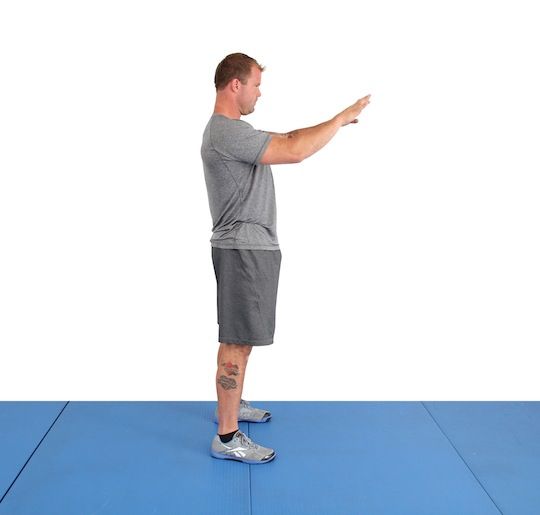
The key to executing a perfect squat is to start in a good position. This means bracing your spine in a neutral position and creating torque (stability) by screwing your feet into the ground.
To begin, establish your squat stance with your feet just outside your shoulders with your feet straight – somewhere between 5 and 12 degrees – and your weight centered over the center of your feet or just in front of your ankles. Note, the straighter your foot position, the more torque you can create. And the more torque you can create, the easier it is to maintain stability (good position) as you descend into the squat.
Next, squeeze your glutes as hard as you can, align your ribcage over your pelvis, and then lock in the position by engaging your abs. Keeping your belly tight, screw your feet into the ground as if you were trying to spread the floor. To be more specific, screw your right foot into the ground in a clockwise direction and screw your left foot into the ground in a counterclockwise direction.
Finally, align your ears over your shoulders and look forward to maintain a neutral head position. As you do this, set your shoulders in a stable position and tighten your upper back by lifting your arms to chest level, pulling your shoulders back, and externally rotating your hands slightly.
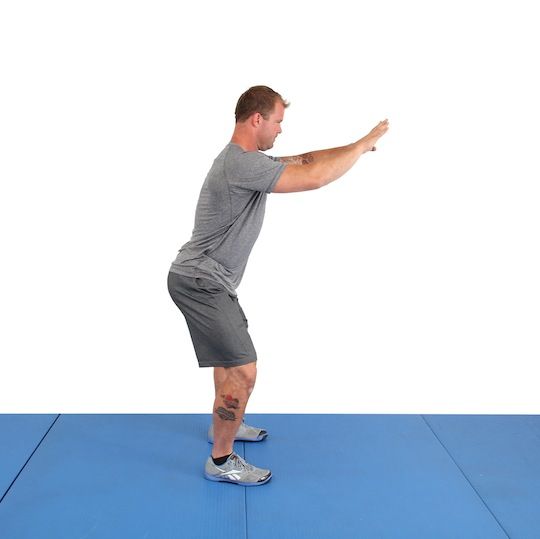 |
| Add caption |
Step 2: Load your hips and hamstrings
Keeping your back flat, reach your hamstrings back, drive your knees out laterally, and start lowering into the bottom position. Note: I say, hamstrings back because the drive your hips back cue can cause people to overextend at their lumbar spine. In addition, focus on keeping your shins as vertical as possible. This allows you to channel your weight and power into your hips and hamstrings, which are the muscles designed to handle the load. If your knees translate forward, you’ll lose power from your posterior chain and increase the shear (twisting) forces to the soft tissues within in the joint (patellar tendon, ACL, etc.)Step 3: Pull yourself into the bottom of the squat
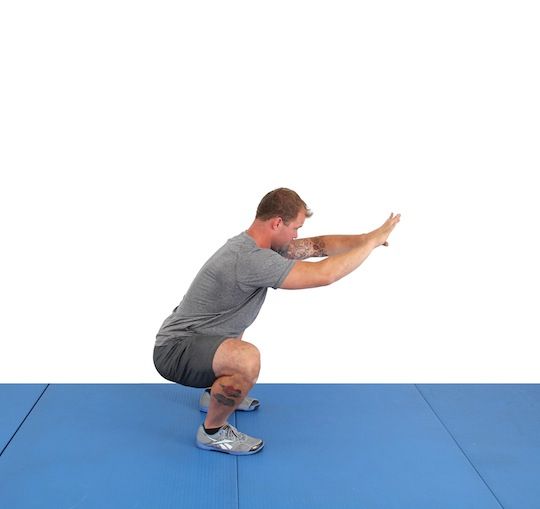
Most people have no trouble bracing their spine in a neutral position and hinging from the hips. Lowering into the bottom of the squat, on the other hand, is where things start to fall apart. This is where the invisible becomes visible. If you’re missing range of motion or you don’t have the motor control to perform the movement, this step in the sequence will illuminate your weaknesses.
As you lower into the bottom position, continue to screw your feet into the ground and drive your knees out – keeping your back flat, belly tight, and shins vertical. To maximize tension in your hips and hamstrings, think about pulling yourself into the bottom position instead of dropping into the bottom position. The goal is to drop your hip crease below your knee crease.
It’s important to note that if you can’t descend into the bottom of the squat with proper form, you should reduce the depth of the squat. The last thing you want to do is ingrain wonky movement patterns for the sake of performing the full range movement. It’s a simple rule: Don’t sacrifice form for range.
With that being said, every healthy human being should be able to perform a butt-to-ankle squat. After all, the bottom of the squat is really just Grok’s Paleolithic chair.
Step 4: Drive out of the bottom position
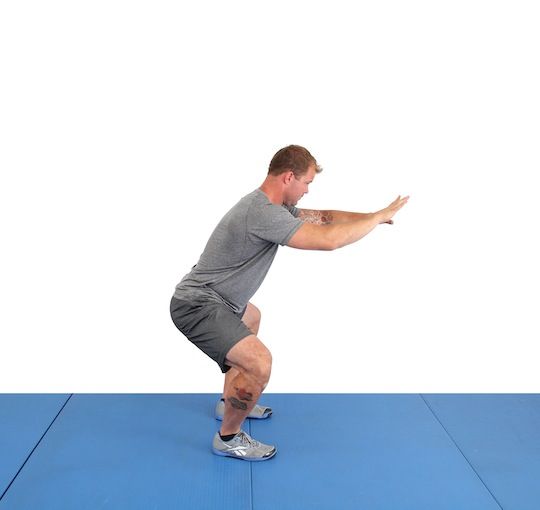 Rise out of the bottom position the same way you lowered into the squat: with your trunk braced, your back flat, your knees out, and your shoulders and upper back tight.
Rise out of the bottom position the same way you lowered into the squat: with your trunk braced, your back flat, your knees out, and your shoulders and upper back tight.Step 5: Reestablish the top position
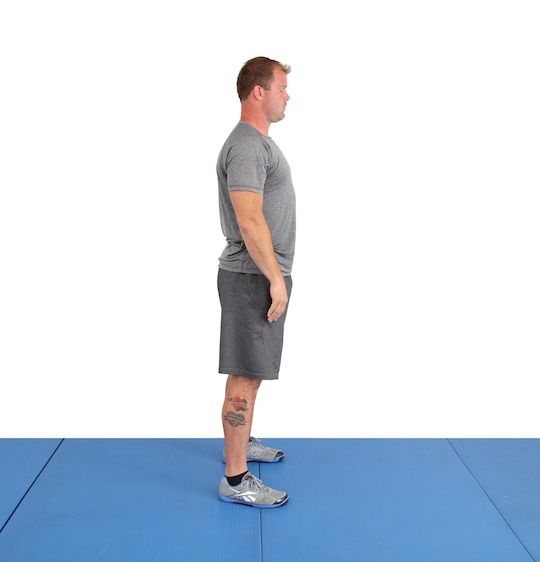 As you stand up, reestablish the top position by squeezing your butt. Remember this sequence and practice it every time you squat.
As you stand up, reestablish the top position by squeezing your butt. Remember this sequence and practice it every time you squat.Mobility Rx
Learning how to squat with good form is always the first step. But what if you can’t keep your shins vertical or your back flat as you descend into the bottom position? What if you can’t keep your feet straight and your knees out as you hinge from the hips? Well, assuming it’s not a motor control issue – meaning you understand how to perform the technique correctly – there’s a good chance that you’re missing range of motion in one or more of your joints and tissues.Pinpointing the problem area can be difficult. Your body is a system of systems. It takes some experimenting and some diligent mobility-time to get to the bottom of your business. The key is to spend time mobilizing in the positions that are giving you the most trouble. For example, if you’re unable to open up your hips in the top position because your hip flexors are tight, perform the Couch Mob. If you’re struggling in the bottom of the squat, mobilize in a position that looks like the bottom of the squat. Simple.
Couch Mobilization

Single Flexion with External Rotation Bias
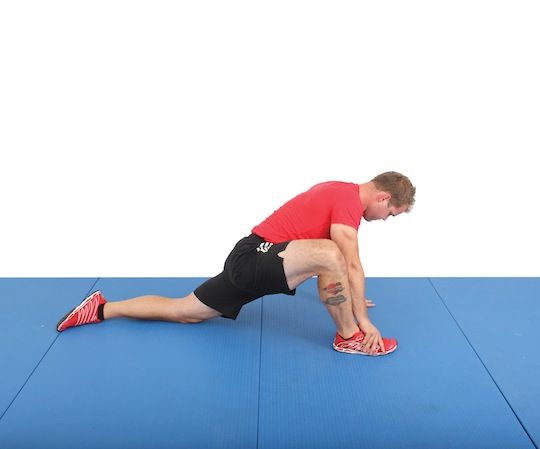 If you’re missing range of motion or you’re in pain, you can do something about it. Remember, you are an impeccable healing machine. Adopt the right lifestyle and get to work on fixing your crummy positions and movements.
If you’re missing range of motion or you’re in pain, you can do something about it. Remember, you are an impeccable healing machine. Adopt the right lifestyle and get to work on fixing your crummy positions and movements.To help illustrate how position and mobilization techniques can improve your squat, here are some relevant MWOD (Mobility Workout of the Day) videos:
Squat Quick Test: Is It Your Ankles or Hips?
Tight Ankles, Bad Squatting
Episode 363: Pre-Squat Hip Opener Mob-Rx
Daily Prog: 1/3 Squat Cycle
Daily Prog: 2/2 Squat Cycle
Daily Prog: 3/3 Squat Cycle
To learn more about Kelly Starrett’s Movement and Mobility system, check out his new book, Becoming a Supple Leopard: The Ultimate Guide to Resolving Pain, Preventing Injury, and Optimizing Athletic Performance and visit mobilitywod.com






0 comments:
Post a Comment